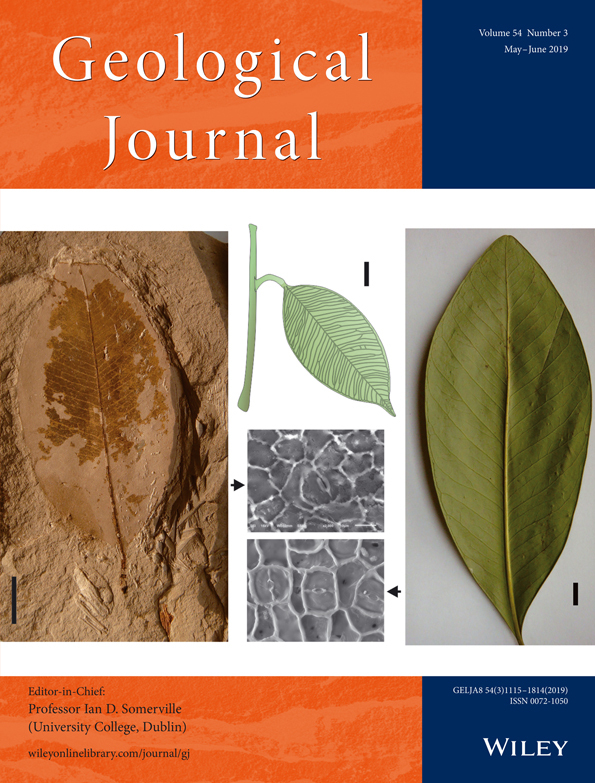Sequence architecture and depositional evolution in Lufeng Depression, Pearl River Mouth Basin, South China Sea Part B: The shore deposits of Zhuhai Formation
Abstract
The Zhuhai Formation in Lufeng Depression is mainly deposited during a depression stage. In this paper, we employ cores, wireline logs, and seismic reflections to reveal sequence architecture and depositional evolution in target intervals. The results indicated that one second-order sequence and two third-order sequences were identified and sequence stratigraphic framework was established. The second-order sequence was developed in response to base-level falling, while third-order sequences were mainly formed during base-level rising. In addition, each third-order sequence did not change too much in thickness. Then the shore deposits (shoreface and foreshore) were delineated, and the depositional characteristics were described within the framework with the help of related data. The shoreface and foreshore deposits within the sequence stratigraphic framework varied significantly in stacking patterns of wireline logs and cores. Based on comprehensive analysis, it can be concluded that base-level changes played an important role in controlling sequence architecture. And lacustrine fluctuations derived from accommodation space changes exerted an essential effect on depositional evolution. This study provides significant insights into revealing the sequence architecture and depositional evolution and discussing hydrocarbon potential in the transition stage in the Zhuhai Formation.
1 INTRODUCTION
The sequence architecture, depositional evolution, and controlling processes of shore deposits in nonmarine sedimentary basins have long been of significance to scientific and realistic interests (Bridge & Demicco, 2008; Somme, Helland-Hansen, Martinsen, & Thurmond, 2009; Somme & Jackson, 2013; Somme, Jackson, & Vaksdal, 2013; Somme, Martinsen, & Thurmond, 2009; Wood & Ethridge, 2012; Xu, 2013). It has been widely accepted that tectonics, lacustrine fluctuations, climate changes, and sediment supplies are the main factors in controlling sequence architecture and depositional filling (Cullen, Reemst, Henstra, Gozzard, & Ray, 2010; Donders et al., 2009; Hayes & Nissen, 2005; Hietpas, Samson, Moecher, & Schmitt, 2010; J. J. Chen, Ma, & Sun, 2015; Lin, Xia, Shi, & Zhou, 2015; Manson et al., 2017; P. L. Li, 1993; Romans, Castelltort, Covault, Fildani, & Walsh, 2016; S. T. Li, 2015). However, the interactions of the main factors, which drive the development of the sequence architecture and depositional filling, are known to be integrative and complex within the different basins. In addition, it has been observed that the controlling factors play various roles in the different stages of a basin's evolution. The Pearl River Mouth Basin (PRMB) is a continental-margin basin, which is located in the central part of the northern continental margin of the South China Sea. This area experienced rifting, transition, and depression stages during the Cenozoic period. Also, due to the immature exploration status and complex tectonics in the PRMB, the sequence architecture and depositional filling, which occurred during the transitional stage, still remain controversial topics (Liu et al., 2015; Zhao & Deng, 2009). Therefore, methods for determining the sequence architecture and depositional filling during the transition stage have aroused wide focus among both domestic and international researchers. In this research study, considering was given to the fact that there were limited wells and cores. Thereby, this research aimed to employ the advantage of the networked seismic volumes (seismic sections and attributes) in order to discuss the sequence architecture and depositional filling in the study area. The results of this study provided robust insights for the fields of hydrocarbon exploration and exploitation.
2 REGIONAL GEOLOGICAL SETTINGS
The Pearl River Mouth Basin (PRMB) is a Cenozoic rift basin, which developed on the northern passive continental margin of the South China Sea (SCS; Figure 1). This basin is located among the Indo-Australian, Eurasian, and Pacific plates (Barckhausen, Engels, Franke, Ladage, & Pubellier, 2014; Cullen et al., 2010; Ru, 1988; Wang & Li, 2009; W. L. Zhu et al., 2015). It is widely known that, from the north to the south, the PRMB consists of three uplifted zones, which are referred to as the Northern, Central, and Southern Uplift zones, as well as three depression zones, which are referred to as the Southern, Central, and Northern Depression zones. Previous studies have demonstrated that the most cited model concerning the tectonic evolution for rifting was that the PRMB experienced two tectonic evolutionary stages as follows: a rifting stage ranging from the Palaeocene, Eocene, to Oligocene and a postrifting stage ranging from the Early Miocene to the Pliocene (Cullen et al., 2010; Hutchison, 2004; Xie et al., 2015; Xie, Rem, & Lei, 2012; W. L. Zhu et al., 2015; Zhou, Ru, & Chen, 1995; Zhang, Wang, Wu, Liu, & Xie, 2015). It was observed that four prominent unconformities had developed in response to the synrift stage of the PRMB, which were dated 65 Ma (Tg unconformity), 45 Ma (T90 unconformity), 38 Ma (T80 unconformity), and 32 Ma (T70 unconformity), respectively (W. L. Zhu, Zhang, & Gao, 2008). The unconformity (Tg) at the end of the Cenozoic had separated the synrift sequences from the underlying pre-Palaeogene basement (Yu, Koyi, & Zhang, 2016; W. L. Zhu et al., 2008). The several well drillings, which were made through the unconformity (Tg), confirmed the fact that the basement was mainly made of granite, with some volcanic rock observed in some locations, particularly on the palaeouplift. The unconformities at 65, 45, and 38 Ma indicated that three regional erosional episodes had occurred during the rifting stage. These episodes were referred to as (from the oldest to the youngest) the Shenhu Event, Zhuqiong Event, and Nanhai Event respectively (Figure 3). The 32 Ma (T70) boundary represented the beginning of breakup and seafloor spreading in the central part of the South China Sea and separated the tectonically active Palaeogene strata from the significantly stable strata in Neogene sediments (Ren & Lei, 2011; Yu et al., 2016), as detailed in Figure 3. The unconformity at 23.8 Ma (T60) indicated the end of the rifting stage. The synrift sedimentary sequences (Shenhu, Wenchang, Enping, and Zhuhai formations) were confirmed to be separated by these four significant unconformities. On the other hand, the postrift sequences were confirmed to have included the Zhujiang, Hanjiang, Yuehai, and Wanshan formations (S. Chen, Zhang, & Zhang, 1991; W. L. Zhu et al., 2008).
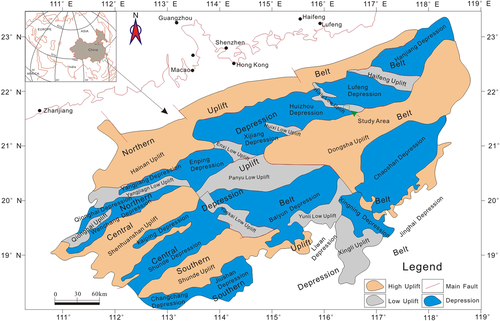
The Lufeng Depression is a new petroliferous site, where several new hydrocarbon discoveries have been found. It is located at the north-eastern end of the NE strike Zhu I Depression, which belongs to the Northern Depression Zone of the PRMB (Figure 2). The Lufeng Depression covers an area of approximately 6,500 km2, and only a few areas have been covered by 3D seismic surveys. For the current study area, which was located in the south-western section of the depression, seismic merged surveys that had been acquired during different years were utilized (Figure 2).
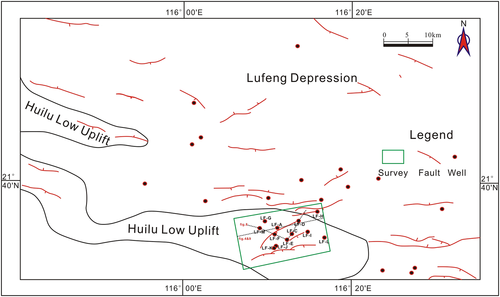
It is known that complex tectonic movements resulted in the multiple stratigraphic responses in vertical successions (Figure 3). In regard to the target interval Zhuhai Formation, the detailed descriptions were as follows: The lithology of the Zhuhai Formation could be divided into two sections in the study area. The lower part was dominated by pure sandstone, with some interbedded red layers. In contrast, the upper part was composed of interbedded sandstone and mudstone, which were deposits that had resulted from the marine to nonmarine environments. The deposits of the Zhuhai Formation were observed to be widely distributed, due to the flatness of the geomorphology (Figure 3).
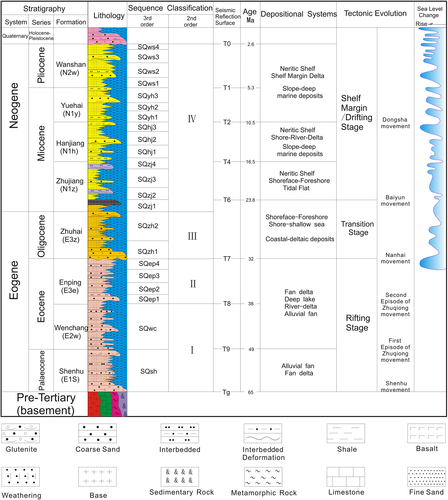
3 DATABASE AND METHODS
This study was based on data from the 45 boreholes drilled in the study area by the China National Offshore Oil Corporation. Each well was composed of an extensive and consistent suite of conventional wireline logs, which included the following: gamma ray (GR), resistivity (RES), calliper (CAL), spontaneous potential (SP), acoustic travel time (AC/DT), and bulk density (RHOB). The 3D merged seismic volume, which had been recently reprocessed (as mentioned in the research conducted by Xia, Liu, Luo, & Shu, 2017), covered an area of approximately 180 km2 in the south-western region of the Lufeng Depression. These data were used and analysed in the current study (Figure 1). However, there was minimal high-quality core coverage from six of the wells, and only two of these contained cores of the Zhuhai Formation. The methodology, which was used in this study for revealing the sequence architecture, was more or less the same as that described by Xia et al. (2017). It followed a logistic workflow of recognizing different-order unconformities (mainly second and third orders), tracing and correlating the sequence boundaries, and establishing the sequence stratigraphic framework following the fine structural interpretations of the 3D seismic merging volumes and profiles. In addition, a facies analysis was carried out in regard to the lithology, grain size and sorting, primary sedimentary structures of the cores, stacking patterns of the wireline logs, and internal architecture and external geometry of the seismic reflections. In regard to the prediction of the facies distributions, it also displayed a workflow similar to that utilized by Xia et al. (2017).
4 SEQUENCE CLASSIFICATION AND ARCHITECTURE
The concepts and principles, which originated from the marine realm (Catuneanu, 2002, 2006; Catuneanu et al., 2009; Catuneanu et al., 2011; Catuneanu, Martins-Neto, & Eriksson, 2012; Van Wagoner et al., 1988), were applied in a straightforward manner to the shore deposits. It was found that the use of sequence stratigraphy, rather than lithostratigraphy, to correlate the genetic packages of sediment in the Zhuhai Formation, provided more appropriate information regarding the lacustrine rift basins regardless of the stage (rift, transition, or depression stages), in which similar lithologies may be produced by several lacustrine cycles. Unlike the tectonic settings in the Enping Formation (Wang & Li, 2009; Xia et al., 2017; Zhang et al., 2015), the deposits in the Zhuhai Formation had developed in response to the transition stage. The classification of the sequence stratigraphy and interpretations of the sequence architecture in the Zhuhai Formation are described by the above-mentioned database.
4.1 Sequence classifications
In this study's comparison of the sequence classifications (Xia et al., 2017), it was determined that the differences between the Enping Formation and Zhuhai Formation were the sequences, which were deposited during the different basin evolution stages (Figure 3). Therefore, the principles for the identification of the sequence boundaries in the Zhuhai Formation were defined as follows: (a) There should not be any other significant sedimentary hiatus than the one used for identifying the sequence boundaries; (b) all the sediment within the sequence stratigraphic framework should be chronostratigraphic; and (c) the sequence boundaries identified with regard to the different databases should be the same (Ji, Zhao, Shan, Zhang, & Wang, 2009; X. M. Zhu, Kang, & Wang, 2003). Then, based on these principles and databases, the sequence classifications were carried out in the Zhuhai Formation (Figures 4 and 5).
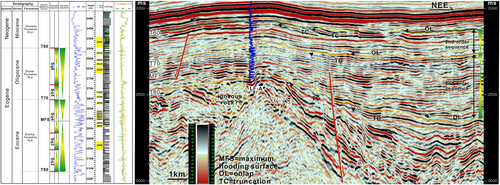
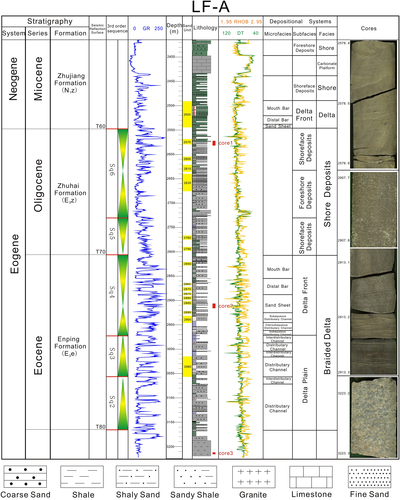
The results of the sequence classification in the Zhuhai Formation during the transition stage confirmed that one second-order sequence and two third-order sequences could be identified based on a comprehensive analysis of the cores, wireline logs, and seismic reflections. The division of the different-order sequences in the Zhuhai Formation was in response to the base-level changes of the shore deposits. The principles of the identification for the sequences were previously described by Xia et al. (2017).
4.2 Sequence architecture
The key for the delineation of the sequence architecture during the transition stage was to divide up the different-order sequence boundaries (Catuneanu, 2002; X. M. Zhu et al., 2003). The base (T70), along with the top (T60) of the Zhuhai Formation, was bounded by second-order unconformities, which were generated as corresponding to the regional base-level changes. However, the base (T70) had previously been described by Xia et al. (2017). In contrast, the top (T60) shared similarities with T70 in regard to seismic responses. The differences were observed in the stacking patterns of the wireline logs. In regard to the GR value, there was a distinct shift observed in the mudstone baseline, below and above T60. The thickness of the second-order sequence from the given seismic section was found to change only slightly. In addition, two third-order sequences were identified within the Zhuhai Formation. Generally speaking, records of local transgressive–regressive depositional cycles are kept. In this study, the sequences of sq5 and sq6 were the target intervals in the Zhuhai Formation. It was known that sq5 developed in response to a base-level falling process. The bottom of sq5 appeared as an unconformity, with truncation below and onlap above the surface on the seismic section (Figure 4). It could be traced and correlated throughout the basin due to the wide and flat palaeogeomorphology of the area. The bottom surface of sq5 appeared as a weak amplitude, and discontinuous reflections on the uplift, which gradually turned into a strong amplitude, and continuous reflection towards the central part of the basin (Figure 4). The thickness of sq5 tended to be symmetrical within the entire basin. It was composed of several low-amplitude funnel-shaped stacking patterns, which could have been interpreted as a shoreface with regard to the previous analysis of the palaeoenvironment. The sand sections 2,790 and 2,760 were deposited in sq5. Unlike the depositional cycle in sq5, sq6 was composed of an entire transgressive to regressive depositional cycle. The lower cycle was characterized by a finning-upward trend and cylinder-shaped sandstone. Meanwhile, the upper cycle appeared to be coarsening-upward funnel-shaped sandstone. In addition, there was a maximum flooding surface identified between the base-level transition surface. In sq6, there were observed to be many sand sections developed including 2,630, 2,610, 2,600, and 2,570 m (Figures 4 and 5).
5 SEDIMENTARY FACIE TYPES AND DEPOSITIONAL EVOLUTIONS
The basic G–G data (geological and geophysical) from the cores, wireline logs, and seismic volumes were employed in this study to identify the sedimentary facies and also to interpret sedimentary environments (Catuneanu, 2002; Hutchison, 2004; Z. X. Jiang, 2010; Wang & Li, 2009). The data, which were collected, were used for characterizing the sedimentary facies for the Zhuhai Formation. Then, the seismic attribute-related manipulations were utilized to describe the determined sedimentary facies in the areas without wells, as well as to characterize the sand-body distributions.
5.1 Sedimentary facies type
The detailed analyses of the sedimentology and geophysics (such as the seismic reflections, wireline log stacking patterns, cores, and sedimentary structures) allowed for three main facies to be identified within the study area (Figure 5). These identifications provided an overview of the facies and their lithological associations in a graphical table form as follows: (a) shoreface deposits, (b) foreshore deposits, and (c) maximum flooding surface deposits.
5.1.1 Shoreface deposits
The shoreface deposits were found to have been mainly developed in response to the water fluctuations in the early and late stages of the Zhuhai Formation. The core photo in the study area showed interbedded sandstone and siltstone, along with some calcareous deposits from the bottom to the top (Figure 6a). In addition, it could be seen that the core was dominantly characterized by medium- to fine-grained, medium-sorted sandstone and siltstone (Figure 6). There were no significant sedimentary structures observed from the cores. However, some glauconite (Figure 6b) and a slight amount of bioturbation (Figure 6c) were observed in the cores. Meanwhile, the lithology of the cores was observed to change from the bottom to the top, and this could be used to interpret the changes in the sedimentary environment. In the usual cases, relatively coarse-grained sandstone will indicate strong hydrodynamic environments, while calcareous deposits above are normally interpreted to be weak hydrodynamic environments. Furthermore, that particular section can be an index for lower shoreface deposits, as well as water depth increases. Then, in the study areas, small amounts of interbedded sandstone and siltstone were found with slight cross-beddings, which were interpreted to be upper-medium shoreface deposits (Figure 6). The grain size of the cores indicated a long distance from the shoreline. However, the cores were found to contain poorly sorted and angular-subrounded deposits, which demonstrated a short distance from the provenance. The stacking patterns of the wireline logs also displayed coarsening-up cycles, which also confirmed gradually increasing hydrodynamic forces. The seismic sections were characterized by weak-medium, low-frequency, and uncontinuous seismic reflections. Also, the changes in the seismic events were found to be largely related to the hydrodynamic process (Figure 8). Moreover, the superimposed seismic events on the seismic sections could be interpreted to be sand bars along the shoreline, after being calibrated with the wireline logs on the synthetic seismogram (Figure 8).
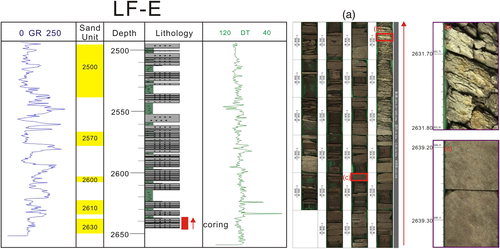
5.1.2 Foreshore deposits
The foreshore deposits were dominantly located in the middle of the Zhuhai Formation. Generally speaking, the cores showed that these deposits were mainly composed of coarse-grained and poorly sorted sandstone (Figure 7a). Also, some coarse-grained sandstones with no sedimentary structure (Figure 7b) and low-angle cross-beddings (Figure 7d) were found on the cores. Occasionally, angular mud pebble and sharp surfaces resulting from the abrupt changes in lithology could be seen on the cores (Figure 7c). The changes in the lithology indicated fluctuations between the exposed and flooded surfaces. The stacking pattern of the wireline logs displayed serrated cylinder shapes, which indicated a strong hydrodynamic process (Figure 7). It was characterized by sheet-like seismic reflections with a strong, low frequency, and continuous amplitude (Figure 8). It was also observed that the seismic reflections in these two different deposits varied from each other. This was determined to be mainly due to the fact that the sedimentary environments resulted in differences in the lithology, as well as the associated seismic reflections.
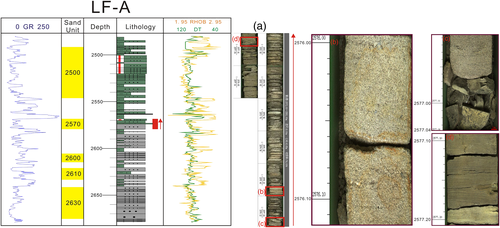

5.1.3 Maximum flooding surface deposits within Zhuhai Formation
In regard to the maximum flooding surface, it was determined that the separating surface of the retrograding strata below and the prograding strata above were equated with the condensed sections related to very slow depositional rates (Catuneanu, 2002; Lin, 2009). It is known that in coastal settings, the maximum flooding surface is placed at the top of the youngest estuarine facies. Therefore, the position of this surface may indicate an abrupt increase in tidal energy from the shoreface systems to the overlying foreshore systems during progradation. Furthermore, the tidal influences in fluvial–deltaic strata may occur within a few tens of kilometres from a coeval shoreline. This tended to be exhibited as parallel or subparallel reflections on seismic profiles within the Zhuhai Formation. Also, it was characterized by an abrupt change in the stacking patterns of the wireline logs, with high gamma rays and low-resistivity signals within the background low gamma ray and high-resistivity sections (Figure 8). Moreover, the gamma-ray stacking patterns for the maximum flooding surface deposits displayed trends of coarsening-upward above and fining-upward below (Figure 8).
5.2 Depositional evolution
5.2.1 Extraction and analysis of the seismic attributes
In this study, a similar methodology for the extraction and analysis of the seismic attributes was employed to reveal the evolution of the depositional systems (de Bruin, Hemstra, & Pouwel, 2007; de Groot, de Bruin, & Hemstra, 2006; Xia et al., 2017; Zeng, 2010). The differences in the methodologies, which were used in the Enping Formation and Zhuhai Formation, were determined to be the seismic attributes produced in the different geomorphology by a dip-driven approach in the Wheeler-transformed domain (Figure 9). However, the geomorphology in the Zhuhai Formation was found to have an obviously flat and stable topography. In addition, the sedimentary facies in the Zhuhai Formation were significantly different from that with the Enping Formation. Therefore, the geomorphic evolution and subsequent depositional evolution in the Zhuhai Formation seemed to be much more suitable for the employment of chronostratigraphic slices.
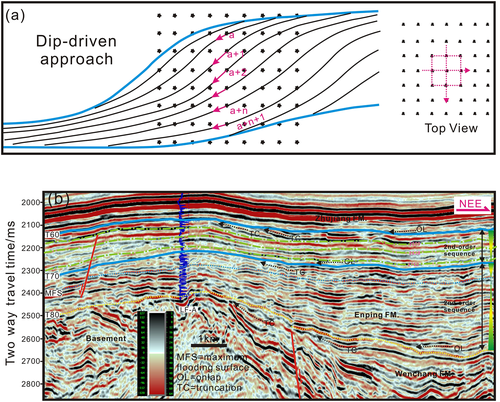
The seismic attributes, which were extracted from the chronostratigraphic slices, proved to be much more reliable and convincing in the identifications of the sedimentary facies, as well as in revealing the depositional evolution in the study area. The arc length seismic attribute was found to be highly sensitive to the changes in the lithological boundaries of the strong hydrodynamic environments.
5.2.2 Depositional evolution
The analysis of the depositional evolution within the sequence stratigraphic framework provided robust insights into methods for the reconstruction of the depositional history and process and also methods for the prediction of favourable zones for potential reservoir–seal pairing. In this study, limited cores, wireline logs, seismic profiles, and arc length seismic attributes were employed to predict facies distributions and to reveal the spatial evolution with regard to the sand sections (sand sections 2,760, 2,630, and 2,600 m).
It was determined that the sand section 2,760 was deposited during an early period of transition stage (Figure 3). During this depositional period, the base level had fallen further due to tectonic activities. Therefore, decreases in the accommodation space and lacustrine level were the results. Also, the sedimentary facies changed from a braided delta to shore deposits (Figures 5 and 6).
The arc length seismic attribute extracted from sand section 2,760 showed some isolated strong NE-strike seismic responses in the southern part of the study area. The scale and coverage were found to vary from place to place. Therefore, based on comprehensive analysis of the cores, wireline logs, and correlation of the seismic facies, it was concluded that these seismic responses could be interpreted as shoreface deposits (Figure 10a). The previous studies had demonstrated that the study area had been isolated by a barrier during the deposition period of the Zhuhai Formation (Deng & Zheng, 2009; Dong, Zhang, Zhong, Yuan, & Wu, 2009; Lin et al., 2015; Xia et al., 2017; Zhang et al., 2015). Therefore, the geomorphology of the area played an important role in controlling the facies distributions. The sand bars of shoreface deposits, which were mainly distributed in the south-eastern section, were determined to be largely influenced by the palaeogeomorphology. The south-eastern sand bars, which were deposited along the Dongsha Uplift, were characterized by large-scale belt-like shapes, which had resulted from strong lacustrine fluctuations during its deposition. In contrast, the north-western sand bar located a little far away from the shore were characterized by small-scale belt-like shapes, which had resulted from weak lacustrine fluctuations (Figure 10a).

The 2,630 sand section had been deposited at the middle-late period of the transition stage (Figure 3). During this depositional period, the base level had risen and correspondingly resulted in an increase in the accommodation space and water depth (Figures 5 and 6).
The arc length seismic attribute showed some large-scale strong seismic responses with the NE strike in the study area. All of these strong seismic responses were interpreted to be foreshore deposits, in accordance with the combined analysis of the cores and stacking patterns of the wireline logs. The deposits, which were distributed mainly in the north-west, were sheet shaped, while isolated belt-like shapes were observed in the south-east. Also, the facies distributions were found to be significantly different from that in the 2,760 sand section. The reasons for this may have been closely related to the base-level changes (Figure 10b).
The last sand section (2,600) was determined to have mainly been deposited in the later part of the transition stage. During this period, the base level had changed from a rising to a falling trend. The deposits of the seismic responses were interpreted to be shoreface deposits, which were mainly characterized by narrow belt-like shapes (Figure 10c).
5.3 Prospecting predictions
Unlike the prospect potential in the Enping Formation of the study area (Xia et al., 2017), there were few public reports available concerning the hydrocarbon discovered in the Zhuhai Formation. However, there was believed to be good potential in this area for the following reasons: First of all, the physical properties of the sedimentary facies tended to gradually improve due to single-directional water flush from the shoreface to the foreshore deposits in a vertical succession, which may have consisted of favourable reservoirs. The porosity and permeability of the Zhuhai Formation in the study area proved to be relatively good in the foreshore and shoreface deposits and ranged from 4.6% to 12% in porosity and from 5 to 190 md in permeability (Deng & Zheng, 2009; H. Jiang et al., 2012). Secondly, the overlying limy deposits provided a good regional seal for the hydrocarbon preservation. Thirdly, the source rock in the Wenchang and Enping formations had resulted from a rift stage and could potentially provide oil and gas resources, which may have migrated and accumulated in the reservoirs of Zhuhai Formation through faults in terms of vertical and lateral migrations (H. Jiang et al., 2012; Zhang et al., 2015; W. L. Zhu et al., 2015).
6 DISCUSSION
6.1 Responses to the base-level changes
It was found in this study that the development of the sequence architecture and depositional filling in the Zhuhai Formation reflected the variations in the A/S ratio. The sequence boundaries had usually been formed during periods of negative A/S ratios, while the depositional filling periods were associated with positive A/S ratios. It was observed that the variations in A/S ratios were probably mainly related to the tectonic subsidence, sediment supplies, and lacustrine fluctuations during the transition stage in the study area. However, within the second-order sequence, the variations in the Zhuhai Formation were largely dependent on the lacustrine fluctuations in the deposits, which had mainly resulted from the reworked or reconstructed braided delta of the Enping Formation, which were deposited below. These findings indicated that there were only a few landward sediment supplies during the deposition of the Zhuhai Formation. In addition, it had been deposited during the transition stage. Therefore, the tectonic subsidence had not always been relatively active. The braided delta, which had developed in the Enping Formation, provided the basic sediment supply (Wang & Li, 2009; Xia et al., 2017). Then, during a following tectonically active period, there was an increase in the water depth. The lacustrine level rose at that time, which resulted in an increase in the accommodation space during the early to middle stage of the Zhuhai Formation. The strong hydrodynamic environment resulted in remigration and redeposition from the shoreface to the foreshore deposits. Finally, during the later stage of the Zhuhai Formation, the tectonics tended to be stable, and there are no significant changes in the water depth. Therefore, the lacustrine level fell, resulting in a decrease in accommodation space, and then changed once again to shoreface deposits. The variations in the accommodation space caused superimposed shore-related deposits in vertical successions. In other words, the changes in the accommodation space had resulted in the lacustrine fluctuations and depositional evolution during the formation of the Zhuhai Formation.
6.2 Comparison with the depositional model presented by Boyd
The depositional model presented by Boyd indicated a new classification for clastic coastal environments, which were mainly composed of two different processes during marine fluctuations (Boyd, Dalrymple, & Zaitlin, 1992). In the research conducted by Boyd, an emphasis was placed on the morphological and evolutionary components with regard to the controlling factors from the tides, waves, and rivers, respectively (Figure 11). The results of Boyd's study contained the potential to predict the responses and characteristics in the palaeogeomorphology, sedimentary facies, and sequence stratigraphy. It was found that the lacustrine level generally rose from the bottom to the top in the Zhuhai Formation, as described above. Correspondingly, the sedimentary facies changed from shoreface to foreshore deposits. During the depositional evolution, the fluvial process gradually weakened, while the tidal process dominated, which shared a similarity with one of the occasions in Boyd's depositional models. In Boyd's case, it could be concluded that the shore deposits (including the shoreface and foreshore deposits) were usually distributed where the waves or storms dominated in the gulf basin, which facilitated the rising of the lacustrine and sea levels, providing sufficient sediment supplies. Similar occasions were observed in the study area. As the wave power increased during the progradational process, high hydrodynamic environments were usually formed along the shoreline, which benefited the deposition of the shore deposits. Generally speaking, the deposits (especially the sandstone deposits) were observed to be well sorted, with good porosity and permeability, as discussed in the prospect prediction. Therefore, it was concluded that the study area could potentially contain reservoirs in such deposits.
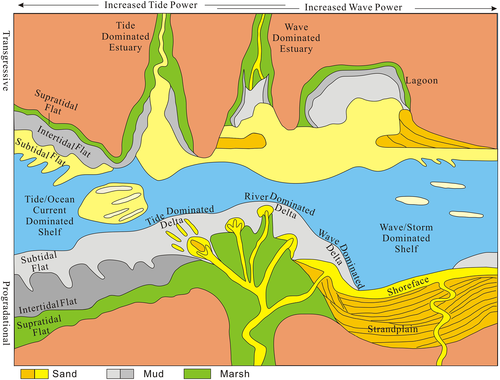
7 CONCLUSIONS
- Based on an integrated analysis of database in the study area, one second-order sequence and two third-order sequences are recognized in the Zhuhai Formation. The second-order sequence was bounded by regional erosional unconformities on seismic profile, while third-order sequences were mainly based on stacking patterns of wireline logs. The second-order sequence is only composed of falling cycle of base-level changes and shows coarsening-upward trend. The third-order sequences usually are composed of falling cycles and occasional rising hemicycle in general. The palaeogeomorphology and base-level changes play an important role in controlling different-order sequence architecture.
- The Zhuhai Formation keeps a record of shore deposits during transition stage. Two significant facies associations are identified based on the seismic and drilling data: (a) foreshore deposits and (b) shoreface deposits. The depositional evolution in Zhuhai Formation is mainly controlled by base-level changes. And it consists of retrogradation in general. The lacustrine changes resulted from base-level changes result in superimposed successions of shore deposits from shoreface to foreshore then to shoreface deposits.
- Although there is still no commercial discoveries in Zhuhai Formation in the study area, however, the potential for hydrocarbon exploration is analysed in terms of source rocks, reservoirs, and seals. With good combination of these factors, it can assist in finding lithostratigraphic traps and making decisions for hydrocarbon exploration and exploitation.
ACKNOWLEDGEMENTS
The Petroleum Development of Oil Research Institute, Shenzhen Branch Company, China National Offshore Oilfield Corporation Limited, is thanked for their kind cooperation, valuable inputs, and helpful discussions. Then the authors gratefully acknowledge the joint financial support from the National Natural Science Foundation of China (Grants 91328201, 40972081, 41130422, and 41172015), the Scientific Research Foundation for Returned Overseas from the Ministry of Education (Grant 2-2-2015-03), the Fundamental Research Funds for the Central Universities (Grant 2-9-2013-095), the State Key Development Program for Basic Research of China (Grant 2011CB201103), and Natural Science Project for Hebei Province (Grants D2013209045, D2015209075, D2017209236, and ZD2016077). In addition, the anonymous reviewers and executive editor are also thanked for their constructive comments, which helped greatly improved the manuscript. Finally, the first author would like to express his grateful thanks to M. A. Li Xin for sparing his babysitting time and energy and devoting all his heart and soul to achieve the results and sublime the understandings for the research. And also, the first author thanks his boy Xia Zixuan to keep his dad's kind company, share his dad's sincere smile, spark his dad's wonderful inspiration, and resonate his dad's passion.



